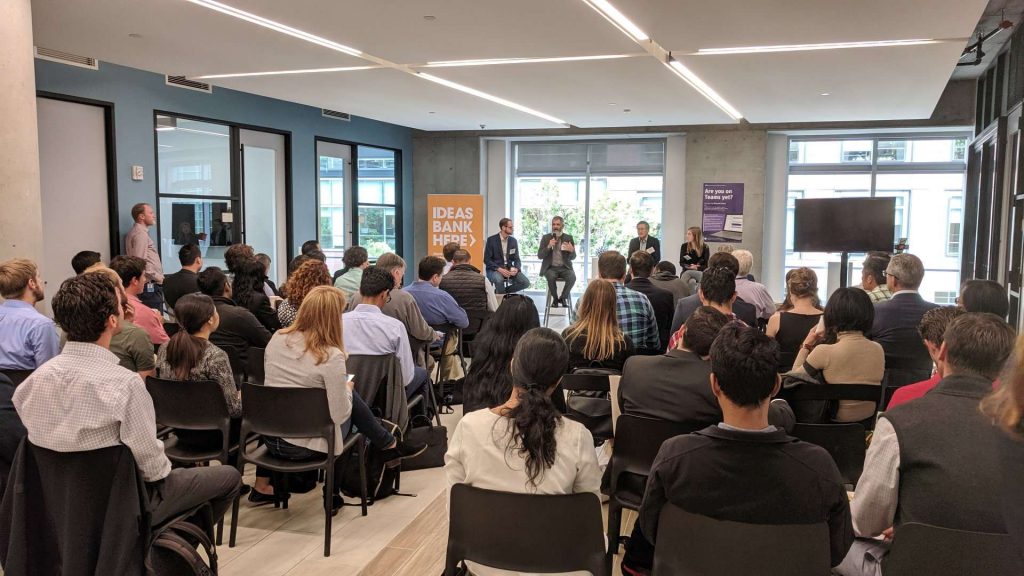Challenges and Opportunities for a Distributed Grid: Opinions from the Latest Power Breakfast
With 80 million smart meters currently in use and 40 million anticipated in the home by 2020, falling electric vehicle (EV) battery costs, smart buildings and growth in renewable energy and energy storage, the centralized grid of the past is becoming more distributed, drawing electrons from these grid edge resources for increased flexibility and reliability in anticipation of a carbon-free energy generation.

Recently, we teamed up with Silicon Valley Bank and Wilson Sonsini Goodrich & Rosati to host a Power Breakfast to discuss the path forward in an increasingly distributed energy system and the challenges to get there. Our speakers included:
- Andrew Hoffman, Chief Development Officer, Leap
- David King, CEO, Foghorn
- Aram Shumavon, Co-founder & CEO, Kevala Analytics
- Emily Fritze, Director of Strategy and Business Development, Powerhouse (Moderator).
Planning for load growth in accordance with climate action goals
Electricity consumption in the U.S. is anticipated to grow, on average, 1% per year until 2050. In addition, this load growth will be geographically diverse, creating various levels of stress on the grid in different places. Planning for load growth, in accordance with carbon reduction goals, poses a challenge for utilities and grid operators.
A major source of the load growth will be EVs, as the electrification of transportation will be key to reaching carbon reduction goals. Building out the grid to accommodate increasing EV adoption will rely on driving (no pun intended) capital efficiency into one of the least capital-efficient industries. In addition, technology platforms and business models designed to analyze charging times and behavior will be necessary to avoid uncoordinated load growth.
David King from Foghorn argued there is plenty of energy supply however, and the main challenge lies in the grid infrastructure, particularly in the network and substations. In a demand response world, the grid is not designed to take energy back in, requiring more advanced intelligence and improved transmission and distribution.
“Building out the grid to accommodate increasing EV adoption will rely on driving (no pun intended) capital efficiency into one of the least capital-efficient industries.”
How can grid edge resources communicate with each other?
Andrew Hoffman from Leap suggests the existence of a large-scale market allowing grid edge resources to participate in the grid will provide the economic incentive necessary to develop a coordinating layer for these resources. Customers are adopting grid edge devices, particularly smart home devices, for more automation and control, but there needs to be more markets to allow those resources to participate and receive a meaningful payment. The opportunity for grid edge participation is significant, as EVs will have the potential to provide more capacity than thermal power when rolled out on a large scale in California. A good example of successful market participation is the Demand Response Auction Mechanism (DRAM) in California, but it is only pilot scale, and large-scale grid edge resource coordination will require a larger market.
Aram Shumavon from Kevala Analytics, on the other hand, believes that designing a wholesale market is a difficult, complicated and slow process, especially if we are trying to predict the capacity provided by each distributed resource. In addition, market manipulation would be inevitable. Aram drew upon Moore’s Law to suggest increasing computing power will allow devices to be much faster and more capable than humans can respond to, creating a large, automated and self-healing network of grid edge resources.
David King took a computing-based approach as well, arguing that, although edge computing has become cheaper, the actual computing capacity of the grid is limited. In order to improve energy capacity models, the computing capacity must be improved, whether that’s in the cloud or in the network. Eventually, the computing and coordinating will get down to the resource level, especially if there is an economic incentive for market participation.
Will we ever think about energy more than we think about Justin Bieber?
Although it likely impacts most of our lives more than Justin Bieber, energy remains a less-discussed topic than the pop superstar. Grid edge resources, particularly EVs and smart home devices, are giving consumers more awareness of, and control over, their energy use. However, increasing automation and new technology such as wireless charging will likely keep energy in the back of users’ minds, which is good for all the Beliebers.
Grid edge innovation then vs. now
Investments in grid edge resources broke records last year, but, barring software, investments in clean technology have not historically performed well. However, this wave of grid edge innovation is different from the past in a few key ways: there are more players in the space, stronger motivations (social, environmental, etc.), a new profusion of smart, connected user devices and massive renewable energy cost reductions. Aram Shumavon pointed out clean technology investing is called risk investing for a reason, much like the internet in its early days. What remains unclear is whether the markets will mature fast enough for consumer devices to participate.
In addition, the renewable energy market will likely fair better now in a recession than in 2008 due to more sophistication around which businesses to fund and how to drive success. Andrew Hoffman noted the grid edge devices of today are fundamentally different than they were ten years ago, requiring less human interaction and creating new business opportunities.
The role of 5G and AI
When an audience member brought up the role of 5G and AI in grid edge innovation, David King recalled first-hand experience when Foghorn raised a Series B round two years ago. At the time, there was no rationale to team up with telecom companies, but now these companies are quickly pivoting to edge technology, AI and 5G for internet of things (IoT) due to increasing use cases (smart vehicles, cities, grid edge devices, industrial IoT, etc.). While still in its early phases, 5G will be a mega trend in the years to come, requiring communication infrastructure investments by utilities. Aram Shumavon took a different approach to this question, noting that everything that needs to be done at the grid edge is only a small apart of 5G’s potential, and thus 5G at the grid edge will become obvious and irrelevant.
New market entrants
An interesting point noted by our panelists is the entrance of consumer technology brands into the energy market. Currently, utilities lack intelligence behind the meter, creating an opportunity for other players to be arbiters of that information. Consumer technology brands such as Apple, Amazon and Google have a stronger presence in the home with the deployment of smart devices, giving them more access to behind the meter intelligence. What remains unclear is how these new market entrants will work within the existing infrastructure and system and effectively use the data gathered from those devices.
What will transportation look like in thirty years? Join us on 8-9 October in Singapore for Cleantech Forum Asia to find out how innovators and investors will assess and solve the problems we face.


